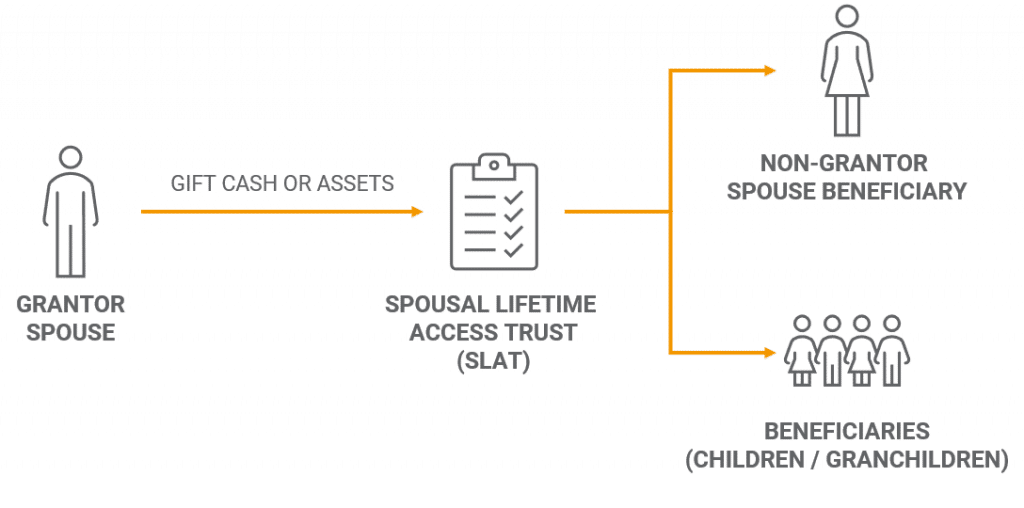Planning an estate could sometimes be a bit difficult but it’s an important part of your financial planning, I know that you would not like to stare down your own mortality. Therefore, if you’ve been thinking about how you would want to pass on your legacy when you die then make a slat trust your next option. However, For effectively planning of slat trust, this article is a detailed guide leaving you with its form, pros, and cons as well as a general overview of what slat trust is all about.
What is Slat Trust?
A SLAT is an acronym for Spousal Lifetime Access Trust. It is an irrevocable trust set up by a spouse for the other during their lifetime. This means this trust is created when the donor spouse is still alive. This is a perfect difference between SLAT and other types of marital trusts that are only done upon death.
They are an inexpensive estate planning tool for couples. As such, they are also are basically an asset protection tool. Meanwhile, it gives access to the gifted funds to the beneficiary spouse, and potentially other beneficiaries such as children and grandchildren instantly.
Read Also: REVOCABLE TRUST: What is Living Revocable Trust?

However, there are many kinds of trusts that function in many ways, but some fall under the category of marital trusts. Thus this kind of trust represents the best way to ensure your spouse is financially secure after you pass away. Besides even with lots of marital trusts there’s a great variety, that makes it difficult to determine which one is right for you. Moreover, as part of an estate Plan, slat is one of the best asset protection tool.
Although, the larger your estate, the larger your federal estate tax liability. Therefore, if you have a federal estate worth more than $25 million then you want take advantage of higher estate tax exemptions, opt for a spousal lifetime access trust (SLAT).
Slat Trust Planning
Establishing a slat trust is a common part of an estate planning process. It is also a great way to reduce your estate tax liability. Desiring for one can help save more money for your family and beneficiaries.
A SLAT trust is an estate planning strategy that can perhaps address conflicting objectives. This type of trust is created by the donor spouse. He/she gifts his/her property to an irrevocable trust for the benefit of the other spouse also known as the non-donor spouse. In addition, they may also include other family members e.g children and grandchildren as beneficiaries. Howbeit the donor spouse can use their federal exclusion in transferring assets to the SLAT.
Read Also: Grantors Trust: A Simple definitive guide (Updated!)
Slat Trust Form
The slat trust form is a legal document that contains list of properties or assets to the transferred into the trust. Therefore before it can be legally bonded, the slat trust form must contain the following;
- The grantor
- Beneficiary(s) or Trustees
- Gifts and Estates of the trust
- Assets Protection
- Financial Forcast
- Witnesses
- Affix stamp and Signatory members
What are the Pros and Cons of Slat Trust?
While there are many pros aspects to a slat planning technique, there are also some cons. Gifted or transferred assets to a SLAT do not receive a step-up in income tax basis at the grantor’s death since they are not included in the Grantor’s taxable estate. Moreover, below are the pros and cons of slat trust.
Pros:
- You can arrange for a slat to avoid state income taxes. You can also protect assets in a SLAT from future creditors and avoid probate.
- A SLAT provides an excellent savings vehicle for couples who regularly put aside assets for retirement
- It helps to Avoid the Pennsylvania and New Jersey Inheritance Taxes.
- It protects your assets depending on the trust’s terms.
- Reduces conflict in case of divorce: This often occurs If each spouse forms a SLAT for the other and divides up assets while the marriage is still healthy. Therefore in case of divorce there will be less conflicts as properties have already been divided.
- A SLAT can also serve as a Dynasty Trust. This is a way of passing wealth from generation to generation without incurring transfer taxes
- The slat assets provide immediate source of care for descendants if the beneficiary spouse dies.
- It is also s Credit Shelter Trust or Bypass Trust set up during life rather than at death.
- Also it can be drafted to keep assets within the family.
Cons:
- If you transfer an asset to the trust, they cannot be returned. Although of the Beneficiary Spouse can always voluntarily share distributions with the grantor spouse.
- In case of they divorce, the SLAT assets are for the beneficiary Spouse.
- If both spouses wish to form trusts for one another, They should be careful as to avoid the IRS’s Reciprocal Trust Doctrine.
- If the Beneficiary Spouse dies, the Grantor Spouse might lose any indirect benefit to the trust. Anyways, a life insurance and other insurance tools can minimize the loss.
- There is no guarantee to the law as it always amended. Therefore todays techniques may not be tomorrow’s technique. The spouse will have to keep up with these changes to make sure the SLAT still provides its demands.
Conclusion
SLAT is a useful tool for married couples who want to secure their estate. Slat helps to reduce estate, gift, and generation-skipping transfer taxes while building flexibility to an irrevocable trust. It may be the first step to help clients get comfortable with engaging in wealth transfer planning. Only clients with strong marriages should utilize a SLAT. If a couple divorces, the donor spouse will lose indirect access to the trust assets through the beneficiary spouse. Only clients with strong marriages should consider utilizing a SLAT.
If there be any divorces, the donor spouse will lose indirect access to the trust assets through the beneficiary spouse. Hence if you wish to opt for slat as your estate planning tool; We advise you to contact an estate planning attorney to discuss how they could be used as a part of your estate plan.






